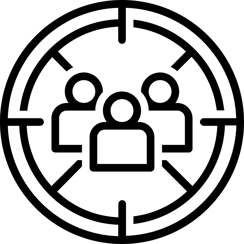Customer segmentation can be described as the process of gathering and grouping individuals based on shared criteria and characteristics. The process of segmenting these individuals can make it easier for an organization to target their marketing efforts in an efficient and effective manner based on a group's common values. If done well, customer segmentation facilitates the configuration of personalized and tailor-made outreach.
In this blog I describe a use case for marketing segmentation within HubSpot.
First things first
The first step of implementation for segmentation in HubSpot is the correct use of properties. HubSpot properties store valuable information about records within your CRM. These properties can be used to store information about customer demographics, geographics, technographics and any other data that your business finds useful. Collecting and storing relevant information about your target market is an imperative step in the segmentation process.
Lets dive into a use case to illustrate this process in more detail. Company A is a logistics company that provides their services globally. Within recent years they have decided they would like to grow in the African market. Company A uses HubSpot to store all information on their customers, such as location, language preference and size.
List creation is key
Once a process has been created and implemented to capture the necessary information within HubSpot properties, HubSpot's active lists can be utilized. The active lists tool enables users to create an automatic list of contacts and/or companies based on specific criteria. This criteria is formed using property values. Records will be automatically enrolled and unenrolled depending on when they meet or no longer meet the set criterium.
Back to our example. As mentioned above Company A would like to grow within the African market. In HubSpot they would like to see an overview on a specific segment of contacts, specifically those located in Africa and have the preferred language of English, with a company size of 500+. Company A creates an active list, using property filters to provide this overview in their portal.
Marketing assets and campaigns
After the desired segmented lists of contacts/companies have been compiled, its time to start creating customer-centric marketing assets. These assets may include marketing emails, landing pages, social posts and more.
Company A has decided to launch a marketing campaign with the aim to reach their goal of growth in the African market in mind. Using HubSpot's campaign tool, they have attached various targeted assets. One specific asset is a marketing email built in HubSpot's drag-and-drop editor using dynamic smart module content delivering specific information determined by list membership.
Easy does it
The final set would include delivering this campaign. HubSpot enables its users to automate many manual actions using workflows. Company A is now ready to launch its marketing campaign starting with a marketing email to a targeted group. The active lists previously created and used to develop these marketing emails can be further used for automation. For example a workflow using the segmented active list as the enrollment criteria. The action attached to this automation may be to send out the directed marketing email.
In conclusion, there are many possibilities within HubSpot CRM to segment and direct your efforts to the right people at the right time!

You may also like

Accessibility for All: HubSpot's Newest Features in 2024

How to get started with reporting in HubSpot

